Food waste is an invisible and expensive habit in our homes. No one wants to waste food, and no one walks into a grocery store and says, “Hey, I’m going to buy all this delicious food today and then throw it out next week.”
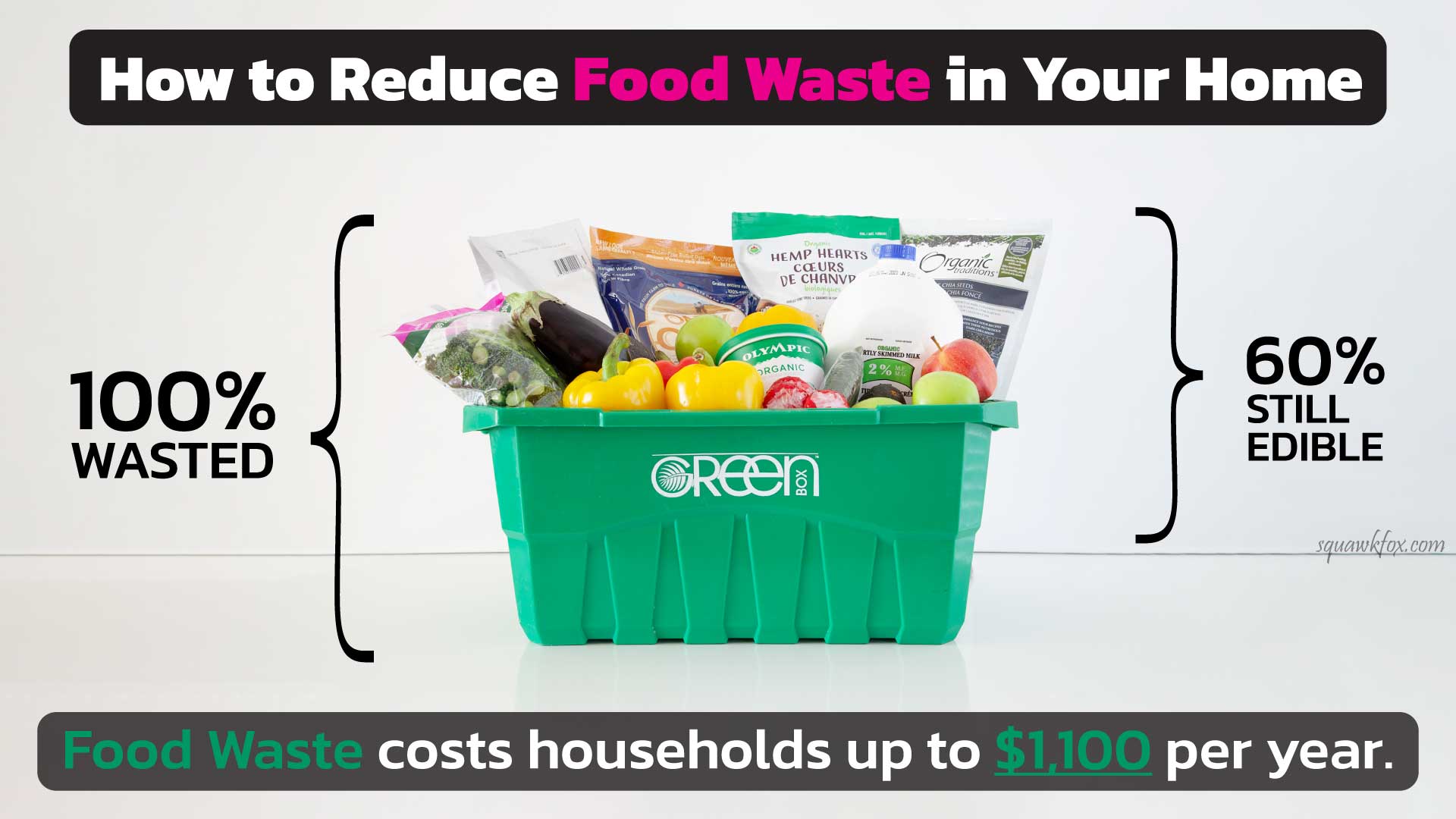
So if your fridge is filled with good intentions but you still manage to garbage your groceries, I’ve got the fresh goods on how to prevent food waste and save up to $1,000 per year.
What is food waste?
Food waste is the forgotten food stuffed at the back of your fridge, the odds and ends that could’ve been a meal but you’re uncertain how to whip it into a recipe, lingering leftovers, and the packaged products a little past the so-called “Best Before” date. All these foodie situations could become food waste.
Food waste is the food that’s OK to eat, but it’s being discarded, composted, or left to spoil without a plan to turn it into a snack or meal.
Food waste happens thanks to a chain of different (and expensive) behaviors starting with
grocery planning, food shopping, meal preparation, languishing leftovers, odd ingredients, and ending with everything in the trash or compost bin.
How much food do we waste?
I didn’t believe the number at first so I asked a behavioral scientist who studies food waste to help out. Angela Cooper, PhD, an Associate at BEworks, says the problem is “pretty big”.
“Over $30-billion of food is wasted per year and about half of that is occurring in people’s homes. We might think it’s the restaurants or it’s the grocery stores, but we as consumers and as homeowners — we’re the culprits.”
How much money is wasted?
Canadian households on average waste over $1,000 per year, says Cooper.
That’s $92 a month, $21 a week, or $3 a day.
“The really tragic part is over 60% of that food is edible. This is what we call avoidable food waste — this is stuff that can be eaten — but maybe it just doesn’t look as nice, it’s a little bit shriveled or not the freshest looking, and this is what gets tossed. [This food] still has use, but a lot of people have an aversion to it.”
How does food waste affect the environment?
Food waste has a massive environmental toll, says Cooper.
“In Canada, over two million tons of CO2 is produced from food waste which is about the equivalent of two million cars on the road. There’s been research that shows if food waste were a country, it would be the third largest CO2 emitting country in the world after China and the United States.”
How to prevent food waste?
BEworks, a behavioral economics firm, did a significant research study with Unilever Hellmann’s to help prevent food waste. After studying over 900 families, they found some very simple solutions that reduced food waste by 30% — saving families at least $300 per year.
Step 1. Place a bowl in your fridge for “food recovery”
We all have ingredient odds and ends that get lost or buried in our fridge. Cooper says the simple act of using a bowl to collect a rogue celery stalk, half tomato, or apple slice “increases salience”, or in my unscience-y terms — hits you in the face when you open the darn fridge!
The idea is if you see it, you’re more likely to use it.
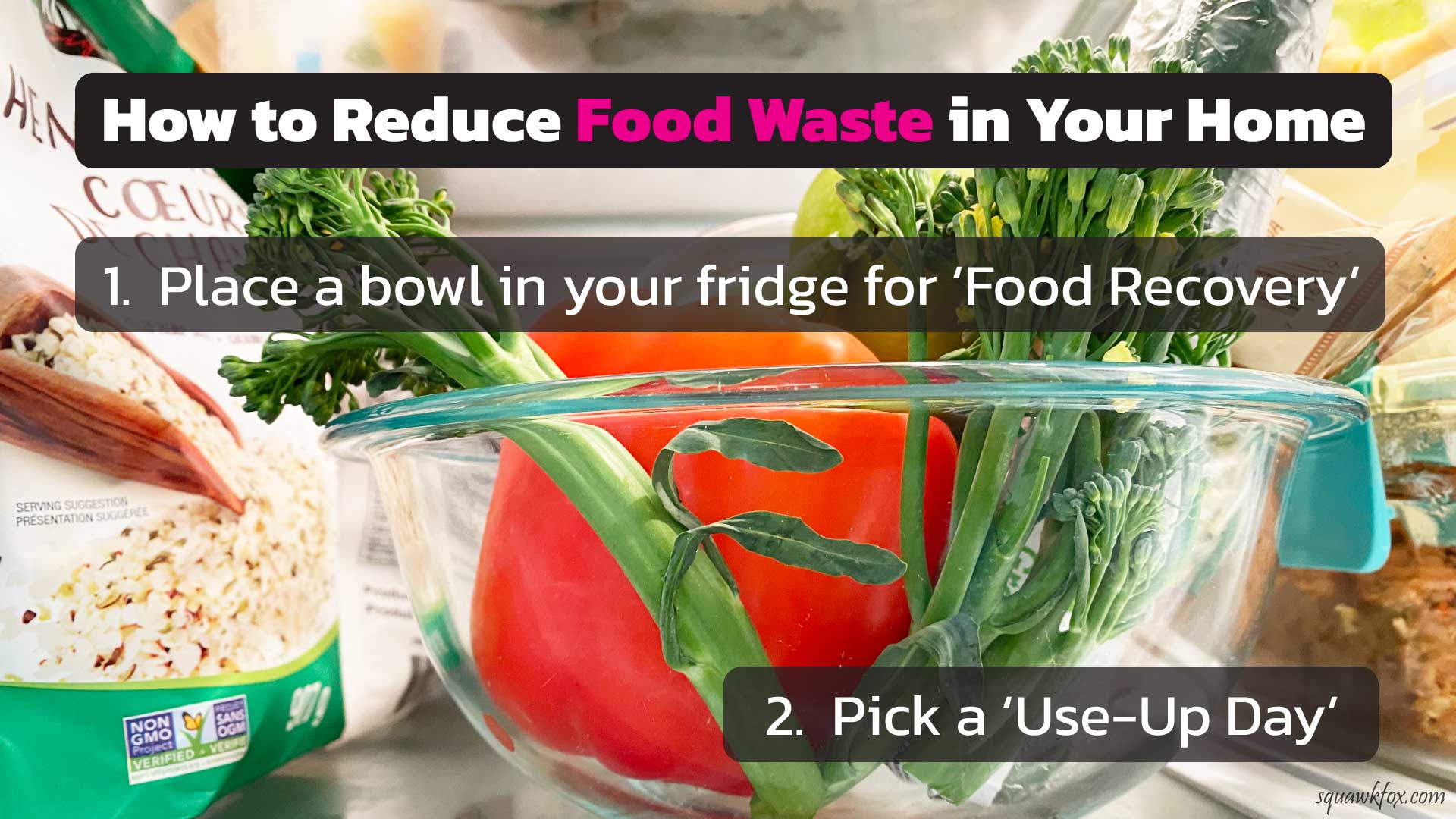
Step 2. Pick a ‘Use-Up Day’
Pick one day per week to make a ‘Use-Up’ meal. Perhaps it’s the day before your next grocery haul, maybe it’s the beginning of the week. Or just pick a random day. I won’t tell.
Step 3. The ‘3+1 Approach’ and a ‘Magic Touch’
So what to do with a bowl of odd ingredients? Here’s where the science of simplicity comes to play. BEworks and Hellmann’s found that giving families a simple formula for how to make a meal with food on hand made it easy to use it up.
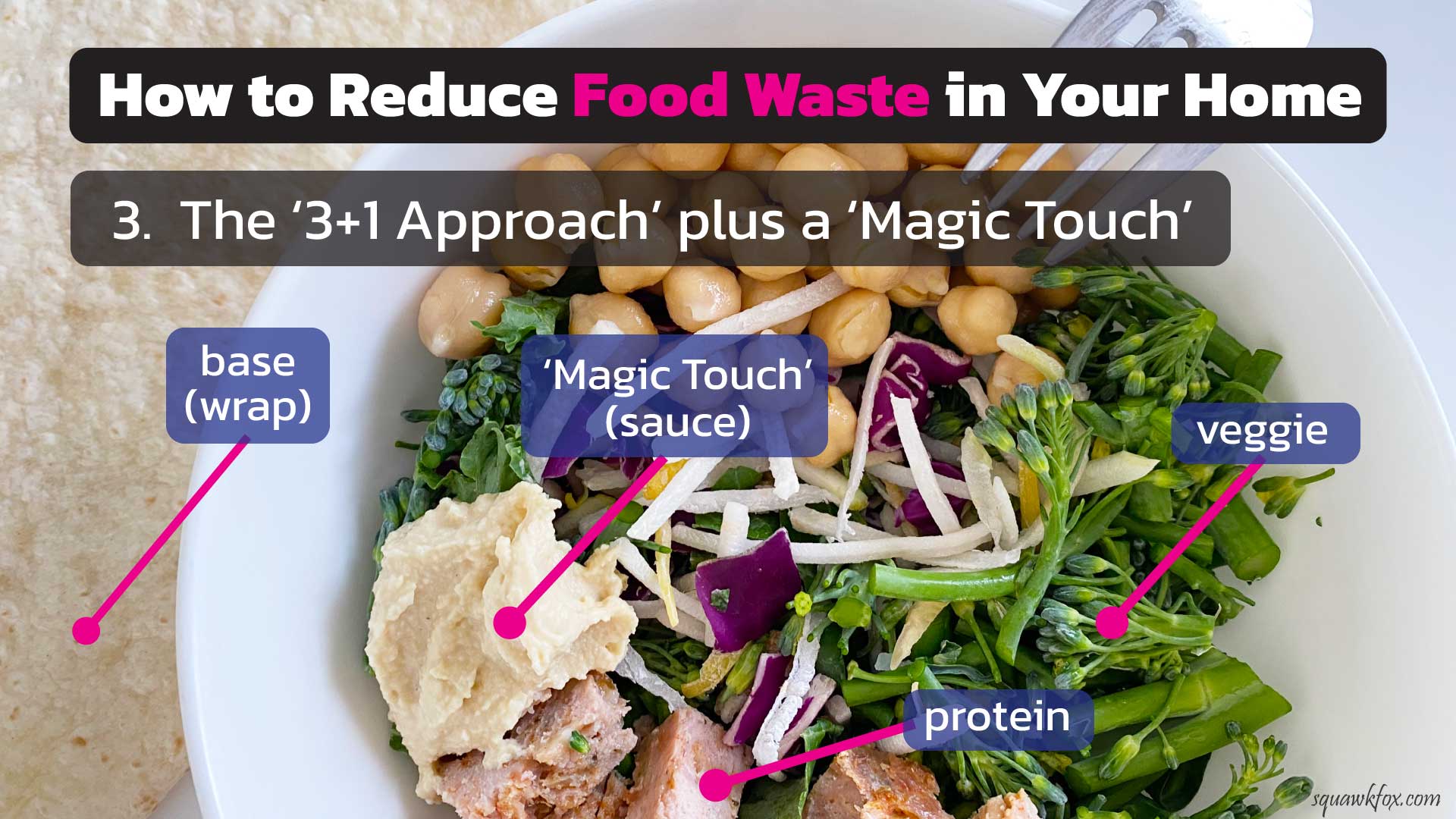
They call it the ‘3+1 Approach’, where you bring together ingredients from three categories: a base (bread, rice, pasta), vegetable or fruit (pick one or a few), a protein of choice (chicken, eggs, tofu, beans), plus a ‘magic touch’ in the form of spices or sauce to bring the dish together and add flavour.
“This is designed to encourage people to substitute, swap out, and think a little bit more flexibly because recipes are very constricting,” says Cooper.
Families were also given 12 flexible recipes using the ‘3+1 Approach’ and showed how to ‘Use-Up’ our most wasted ingredients, such as bread, tomatoes, apples and potatoes.
So a wrap with chicken, lettuce, leftover bell pepper with tomato, and a dollop of hummus or mayo could be a 3+1 use-up recipe for lunch.
Give it a go! (Bonus: Prevent Food Waste Log)
Grab a bowl, choose a ‘Use-Up Day’ and try the ‘3+1 Approach’ for a meal. Making these simple switches could reduce your food waste by 30% (or more!) plus save you hundreds, even $1,000 per year in garbaged groceries.
If you prefer a top-down approach, sure, take my Prevent Food Waste Log for a spin too. But I like the science-backed bowl better. 😉

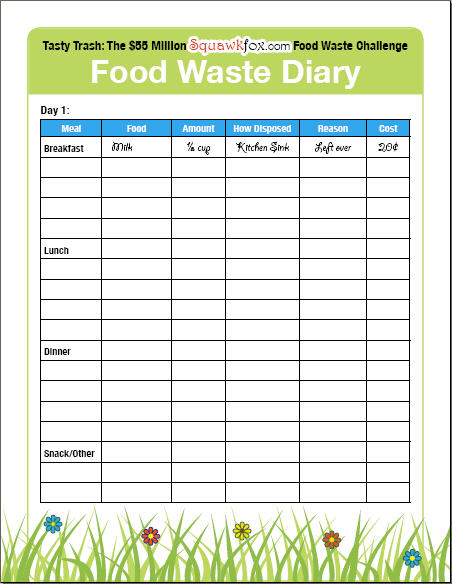
Take these science-backed strategies for a spin and let me know how it goes in the comments!
Love love love,
Kerry



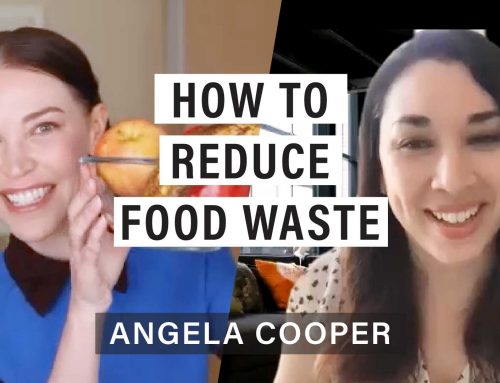

@Sue Awesome!
@Kathy Maybe share this series with a family who could use some savings. 😉
Not much gets wasted in my house! I grew up with my father badgering me constantly about his growing up poor in the depression, and he taught me not to waste anything. Now we have chickens, so any overripe fruit, veggie peels, etc. go to them to be turned into yummy eggs (we also roast and crush their eggshells and feed those back to them). We also feed our dog table scraps and she’s super healthy. The rest goes in the compost. The rare time milk or cream goes sour it gets made into muffins.
I am so in!
I’m in! TEACH me how! I know we waste food, and it bothers me. Every time I walk by the compost bin I swear I see money in there…… I will let you in on a little secret I do have. If I am peeling vegetables for a meal, and am going to be making soup in the next couple of days, I just wash my veggies really well and then I use the peels, stems, other bits we don’t eat to make a wonderful soup stock. I use turnip peels, celery leaves, potato skins, cauliflower stems, etc. Toss in an onion and garlic and spices…..mmmmmmmm soup stock. But I don’t make soup every second day…..and I don’t make enough I could freeze the stock…….
@Sabrina…Since I can’t compost where I live, I like your idea about using those vegetable peelings and scraps for stock. Perhaps they could be stored for stock making in the freezer. My dog always hovers at my feet while I’m preparing vegetables as she loves most raw vegetables and I often give her some of those eat…so that’s another way of not being wasteful and the vet agrees most of the scraps are good for her (no onions or garlic, however!).
One of my waste-saving tips is to go grocery shopping with a list and on a full stomach as you are much less likely to buy more than you need.
Awesome idea.
I know a lot of frugalists say to stay out of the supermarkets, but I actually find that buying small quantities of fresh produce means we eat it all before it goes south. The one thing I am guilty of is buying a container of something like creme fraiche for one pot of soup, so I do try to buy the smallest container I can, even if it is technically more expensive.
I am very excited to read these ideas. I have recently moved from California (local farmers markets everywhere) to the UAE where everything is shipped from Australia or South Africa. As a result, food goes bad very quickly. At first this was highly frustrating to me, who likes to plan the whole week and buy groceries at once. However, I have learned to buy the fresh stuff on an as-needed basis, which means much less waste. Its a change in mindset and I also have to resist the urge to impulse buy as I am in the grocery store a lot more often now…
I know I waste more food than I am comfortable admitting. My main problem is lack of freezer space. We tend to cook in bulk and buy in bulk to save time and money, but our apartment freezer just can’t accomodate leftovers. I am wondering if an apartment-sized deep freezer would be worth-while.
Love it! I’m in !
I’m in!
We have 3 guinea pigs, 2 dogs and 1 cat. When we have vegetables scraps we feed them to the guinea pigs. Who in turn create their own waste. We take that and the straw for their bedding and toss it into the garden. It’s a great cold fertilizer for the garden. We also toss egg shells into the garden to keep away the slugs.
The dogs get any scraps of chicken or steak we can’t use (within reason).
I’m a couponer so I often have extra bread which we put into the freezer. If it goes stale (because somebody doesn’t like whole grains) it is refreshed in the oven or made into crutons.
I also have a stockpile of food items that were bought super cheap by price matching and couponing (thank you MrsJanuary.com !) which we rely on.
But I know there is more I could be doing and I like to see what everyone else has working for them.
I am so in on this. I was feeling proud of myself for composting kitchen scrapes and you shot me down! I had thought myself good at not wasting food what with over stocked canned goods going to food bank, disregarding best by dates when they make no sense, and trying to keep fresh food fresh longer. I just ate a banana that was 4 months old but not over ripe and fine to eat. Kept it in a plastic bag in the refrigerator, peel completely black, still good. Because I live alone now it has meant a big adjustment to cut down and not buy the larger, more economical sizes.
Carry on, Kerry! You are the best.
I’m definately in for this challenge 🙂
Any tips you can offer will be appreciated too…
I’m not sure how composting is still wasteful. We live in the country and keep 2 compost piles; the older one gets tilled into the garden before planting time every spring. We’d be tilling anyway, so where’s the extra cost?
I do agree about wasting food, however. Last week we were struggling through baked beans with too much salt in them, so I found a recipe for baked beans soup, and some sauteed celery and onion, with a can of tomatoes, a pinch of cayenne and dry mustard and NO salt later, I pureed the hot soup and served it with homemade bread. It made a great meal.
Teach me how.
Already baby steps are being taken to minimize waste but still have a lot to learn!!!
I’m in. The Frugal Girl’s Food Waste Fridays have started me down the no-food-waste path, but it is hard and I need constant reinforcement of good habits.
Count me in, too! We’re getting better, but husband and I still do end up tossing out way too much food. We need to get better about creating meal plans, sticking to them, and keeping the kitchen in working/clean condition so we have fewer obstacles to sticking to those plans!!
One of the things I learned many years ago, was to have a mind shift in the way you eat. Chances are everything in the fridge/cupboard is something you like (or else you wouldn’t have bought it, right?). So instead of going to the fridge and asking yourself ‘what am I hungry for?’, open the door and ask yourself ‘What needs to be eaten?’. This way you’ll almost never throw things away.
The other is to realize that the ‘best before’ date is not the ‘goes bad on’ date. If properly stored, many things are good long past the date. Use your senses and your common sence.
Something to note is the size of our fridges and how much perishable food can be stored in all those cubic feet.
I just downsized mine (because it was not energy efficient and it kept me awake!)to a bar fridge which is a little bit too small and I am now saving for a sleek apartment sized LG fridge.
Anyway it challenges me to shop every few days for fresh and wholesome food that will fit in a smaller space which in turn minimizes waste.
Obviously this solution is not ideal for larger families.
Thankfully I don’t waste very much food. I only ever waste lettuce. So now I buy spinach as It seems to keep longer. As a family of 2, fresh food is a lot of effort to keep an eye on.
[…] another kind of challenge, Squawkfox is touting a $55 million Food Waste Challenge. The Canadian site is hoping its 37,000 readers commit to reducing their household waste to save […]
I’m in. As a new mom, i am trying to help save money and keep our expenses down while teaching my daughter about healthy home cooking. I have been reading your blog for sometime now and I have shared your idea from a while ago with my brother about saving veggie scraps in the freezer to make stock later. He thought that it was a great idea!
I can’t wait to get more tips and ideas.
I’m totally in. Just this week I had 5 oranges that got hard in the bag. I decided to experiment by putting them in a bowl of water to see if they would soften enough to peel. After 3 days, I checked and indeed they were soft. I just used the last 2 today. I love saving $$$$!
I am in! I hate waste. I usually make a big dinner on Sundays so we can reheat the next day and the next. BUT, I don’t like eating leftovers. I don’t have time to cook or shop everyday. These tips are great and are giving me ideas on getting more and different uses out of what I have.
I’m in. I don’t think we throw out a lot – but our compost is always full. Hmmmm……I’m willing to have my eyes opened wide.
A couple of years ago we moved to an acreage just outside of Calgary. I started a big vegetable garden and at the end of the summer was able to share my produce with my city friends who don’t have gardens. The thought that some of it might wind up in the garbage freaks me out. The time and energy that goes into growing vegetables is immense. When I lived in the city and bought groceries, even though I spent money on them, tossing them away was pretty common. Growing your own certainly teaches you to respect and value your labours. Nothing just gets thrown in the garbage anymore. I think that if people knew how much work it was, or had to grow their own vegetables, they would be instantly cured of this bad habit.
Looking forward to your tips.
We are a family of three and one of my ways to cut down on wasting food is to meal plan. Some meals are fine as leftovers and we will take them for lunch the next day – some are not. The ones I know my family won’t eat the next day I make sure to make “just enough” for that meal.
I am a widow on a fixed income and have a 20yr grandson whom lives with me.He eats a lot.I hate wasting food.If I have 3 sweetpeas and some juice leftover from a meal it goes into a container in my freezer. I do this until the container is full of whatever meat or vegetables that are leftover. Then I make a big pot of soup. I have a container for chicken and 1 for beef. I buy chicken leg quarters in a 10# bag for $3.90, clean it up, cut it up and put it in bags that contain enough for 1 meal each. In the freezer they go. If I make a big pot of beans I add potatoes(or rice), tomatoes, onions, carrots and anything else I can think of to make a full meal out of it. Then freeze 1/2. I buy fresh vegetables, cut them up, put them in bags and you guessed it. In the freezer they go. I need to try your container gardening idea.We live in an apartment and it looks like a good solution for us.
Count me in
I’m definitely in as well. I hate waste and eat lots of leftovers. However, I do know that things get buried in the back of the fridge and expire. I’m looking forward to reading your tips and tricks!!
We are participating. I have been so disgusted on how much food my family wastes. Some of the ideas I have read already have been great. Look forward to reading the rest.
I’m in! I’m embarrassed by how much food we waste. I need to steward our resources better and I need your tips! Love the idea of looking in the frig for what NEEDS to be eaten. Looking forward to this challenge!
Count me in! Looking forward on how we’re going to this.
I’m in. Our compost bin is always full, and I am shamed to say, but not only with peels and eggshells…..I seem to have trouble with planning meals and I have too much in the cupboards and the fridge, so sometimes things that I don’t even see I have, go bad.
Sounds great! I am very excited by this topic and am looking forward to some good reading ahead. Right now I am big on menu planing and freezing meals and bulk, so I have reduced our waste somewhat.
I am in! I had an extended conversation with friends last week about this very issue! I joked with them that I would start recording our household wastage in an excel worksheet lol! I
look forward to reading your tips! Thank You.
Being a widow & living in a senior cotizens apartment building I try to share meals with other residents. The problem? I am from the South & now am in Ohio. A lot of the people don’t eat the same as we do down south so I freez a lot of leftovers. Some things you just calt cook a small amount of, like gumbo,
I’m in! I’ve already switched from shopping at the grocery store to the farmer’s market – in my mind that will reduce the amount of packaging that has to be thrown away. Still I hate the thought of not using all those fresh foods before they spoil. Teach me 🙂
I’m in! My boyfriend and I hate wasting food, but we do it far too often. We’re trying to be more creative with our meals, but could definitely use some tips!
Yes, I am in for sure!
I,m in. Looking forward to reaching this goal!
I am so in. I already know that I throw out too much on a regualr basis.
I am in too! Any advice that will help me save money will be great!
We are “hundred milers,” but I found myself super frustrated with my CSA. All it took was asking for a substitution for beets and collards with something else, et voila, they found a family who was less fond of carrots and turnips than we are to switch with.
2 lessons learned:
1) sometimes you have to be honest with yourself enough to know that you don’t always live up to the best of your intentions 2) it never hurts to ask
I’m in, too! Every little bit helps
I just was sent a link to tips on making fresh fruit (strawberries, etc) last longer. Soak in a mixture of 1 part vinegar to 10 parts water. Kills mold spores, etc. Dry, and refrigerate. One more way to cut down on food waste!
http://thefrugalgirls.com/2012/04/how-to-keep-strawberries-fresh.html
Absolutely!!!
Sounds great….
I just have a question.. is it just me, or does EVERYTHING have ridiculous expiry dates on the packages? When I was a kid, it didn’t seem to be like it is now.. Case and Point… Dried Bread Crackers have an expiry date? IT’S STALE BREAD!
If you could think of doing an article telling people what reasonable expiry dates are on things, that could probably help a lot of people out..eg, does milk REALLY go bad the day after the best before date?
I have a hard time with food waste because I’m only cooking for the two of us and it’s hard to figure out how to purchase only enough for the two of us for a week’s worth of meals and not go overboard or ‘forget’ something in the fridge.
Count me in!
My strategy for reducing food waste is to have plenty of nonperishable staples like pasta, quinoa and rice on hand al the time but to buy only the smaller amounts of produce and dairy more frequently. If bread goes stale, it gets oven dried and chopped up into breadcrumbs. Great post!
Hey if you have a little chicken or other protein, veggies etc. they can be served up in in a wrap(flat bread). My kids like mango chicken,peppers. Works great for left over baked beans or green salad. My Dad was the king of saving money. He used to wash the bags from the bagged milk and turn them inside out to pack lunches. If there was only a bit of ketchup in the bottom of the bottle, he would add a teaspoon of vinegar and shake and pour it over his fries.His all time saver, never bought hotdog buns,he would save and freeze the end crusts of loaves of bread. They don’t crack when used in place of buns.
Greetings!
i am starting a new club in my High School and we are going to start our campaign about food waste. i have also attended a world student conference in Colorado about food waste …. how can i connect my campaign with your’s?
Another accessible podcast, Kerry. Congratulations. I am converted.
Hi Tea, So happy you liked it! Big love.